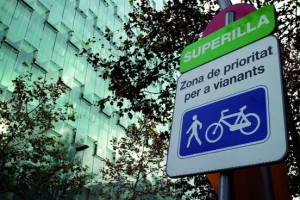Technological and administrative innovation can help to solve cities’ problems, but it’s not enough. We need to ensure that they are guided by innovation in values and social goals: not for private gain but for our collective welfare.
New environmental and energy supply technologies, the growth of the digital economy, emerging services, new ways of doing politics… In a context defined by the widespread growth of inequality, innovation is often seen as a source of hope, a way to solve the problems inherent in our societies.
Thus it is said that economic, social, environmental and political innovation could help not only to mitigate the effects of inequality generated by the economic system, but to actually reduce them: economic innovation would bring about the emergence of new forms of collaborative economy that would reinforce the population’s shared assets and lead to increased welfare; social innovation would allow local communities themselves to provide services under a new set of rules, while improving living standards and empowering underprivileged sectors of society and even generating alternative forms of social and economic organization; environmental innovation would bring major advances to help fight the effects of climate change and to increase sustainability; technological changes could bring decisive political innovations that, through transparency and better access to services, would allow the public to be more involved in democratic processes.
Societies that have been left reeling from the economic and social crisis are thus looking to technological and organisational innovation for the solution to their problems. But is it wise to trust that innovation will solve our urban problems? Can technological change and better administrative processes in themselves bring significant improvements to the quality of life in our cities? Is technological innovation enough to lead us towards higher rates of efficiency, equality and democracy? To address these issues, it would be useful to climb down from the abstract and focus our attention on concrete realities.
Four examples from Barcelona

Notices warning of the negative effects associated with uncontrolled rental of flats to tourists, on a balcony in Barceloneta.
Photo: Vicente Zambrano
One of the most notable recent examples of economic innovation is the rise of the so-called collaborative economy, based on internet connectivity. In Barcelona, its most visible expression has been the growth of tourism generated by new web platforms that offer properties to rent. This has had a marked influence on the sharp increase of tourism in the city, to the point that web-based property rentals now make up almost a third of all visitor accommodation. The positive effects of this process include a reduction in the demand for new-build accommodation, the opportunity for more openness and socialisation in some sectors of the population, and economic benefits. But the process has not been without its problems. It has even led to open conflict in some quarters: higher rental prices, unstable employment for those who work in this sector, the fact that much of the supply is concentrated in the hands of companies and a small number of owners, the lack of fiscal and planning regulations governing the sector, and the commercialisation of both social relations and housing, which is a basic right.
Another area that has undergone massive development in Barcelona in recent years is what is known as social innovation. As a result of the situation created by the economic crisis and the inability of the markets and the authorities to guarantee access to essential goods and services, growing sectors of the population seem to have decided to supply these services themselves. The Map of Social Innovation in Catalonia allows us to identify up to 700 initiatives of this kind, most of them in the metropolitan area. Again, the positive effects of these schemes are very marked, both in terms of access to services and of community empowerment when vindicating their rights and developing alternative forms of social organisation. Nevertheless, the limitations are also obvious: the risk of a benefits culture, the difficulty of defining which communities profit from the schemes, and even the eventual negative effects that these achievements bring. Besides, a study of the social distribution of these schemes shows that they are not necessarily concentrated in the neighbourhoods where the most underprivileged sectors live; in fact, they are mostly found in areas that have been hit by the crisis but that already have more social capital and organisational capacity.

Signposts for Poblenou’s superblock, a groundbreaking experiment as part of a new traffic management strategy that has already attracted international attention.
Photo: Vicente Zambrano
The new transport management strategy that Barcelona is testing out is an important example of environmental innovation that has even attracted international attention. As we know, it is an ambitious proposal that sets out to group city blocks into ‘superblocks’ in which motorised transport is highly restricted and slowed down. The advantages of the project include a much-needed reduction in air and noise pollution; the promotion of non-motorised forms of transport; the reclamation of public spaces; and advances in the fight against greenhouse gas emissions. The scheme’s detractors cite the risk that a better environment will bring considerable price hikes. In this scenario, which has already been seen in other cities, improved environmental quality can become a driver of gentrification and appropriation of urban spaces for purely touristic purposes.
Finally, when it comes to technological innovation in the provision of services and participation in public affairs, it is clear that new developments in ICT will bring significant progress. These developments have a very strong potential to increase the efficiency of services and to give the public more democratic control. But the studies that are available regarding Barcelona show that the population’s propensity to access and use these new media has a very unequal distribution, and poorer groups, women, the elderly and people living on the outskirts tend to use them much less. This digital split could also turn into a fractured democracy.
Governing transformations
The introduction of economic, social and technological innovations does, then, open up notable opportunities to solve the problem of unequal access to income, services and participation in public affairs. But it also brings challenges that must not be underestimated, because these advances are unequally distributed and benefit some parts of the population more than others. The commonly held view that sees innovation as the answer to urban and social inequality is, then, blinkered and without basis. Innovations can be a helpful factor, maybe even an essential one, in improving urban issues, but in no way are they enough in themselves.
The heart of the matter surely lies in ensuring that technological and administrative innovations are guided by innovation in values and social goals. In other words, our capacity-building must be framed and guided, not simply by the search for private gain, but by our collective welfare. Our capacities must be collectively designed and planned so that, when they are applied, they don’t lead to yet further episodes of inequality and urban segregation.
Technological and administrative innovation is not, then, the silver bullet that will solve all our problems. To make innovation work for the collective, we need not less governance of our urban transformations, but more and better; not less political innovation, but more of it.



